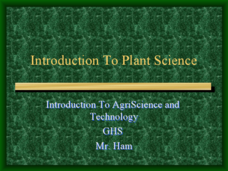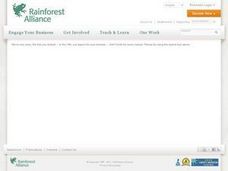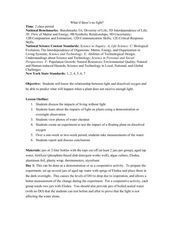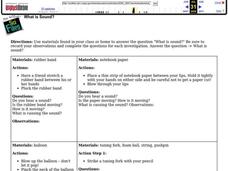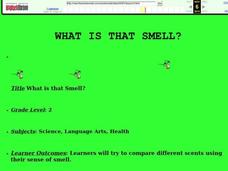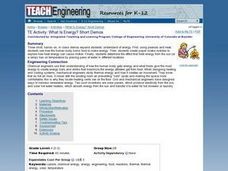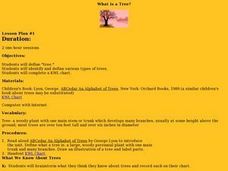Curated OER
Introduction to Plant Science
Although the formatting is less than perfect and some of the pictures are blurry, the information in this presentation on plants is pertinent. Viewers will be able to compare and contrast plants with animals. They will learn about...
Curated OER
What Parts of a Plant Do We Eat?
Did you know that tomtoes and cucumbers are actually fruits? Biology or botany beginners read about the function of flowers and fruit and find that some food items commonly called vegetables are, by definition, also fruits! Give learners...
Curated OER
How Is A Frog Able To Swim In The Trees?
Fourth graders explore the interdependence of frogs and trees. They discuss the various things they need everyday to survive. Students select an animal from their local bioregion and research things that animal is dependent upon for...
Curated OER
What If There's No Light?
students discuss the importance of light and the consequences of living without it. Using a plant as a demonstration, students predict and observe what happens to a plant when it does not receive enough light. In groups, they experiment...
Curated OER
What Genes Do You Have?
A great handout to introduce genetics. Young geneticists will begin to examine which traits are prevalent in their own families, helping them begin to understand the concept of dominant and recessive genes. This is an excellent resource...
Curated OER
What is the Attraction?
Second graders investigate the law of polarity. In this magnets lesson, 2nd graders discover how magnets are used in everyday life and which objects in our environment are magnetic. Students experiment with bar magnets and record...
Curated OER
What is Sound?
In this sound worksheet, young scholars complete 4 investigations to explore sound. These include the use of a rubber band, a blown up balloon, a piece of notebook paper and a tuning fork with a foam ball, string and pushpin. Students...
Curated OER
What is the Rocky shoreline?
Second graders access prior knowledge of the rocky shoreline. In this rocky shoreline lesson, 2nd graders create questions about the rocky shoreline. Students define vocabulary related to the rocky shoreline. Students...
Curated OER
What Is a Species?
Learners are able to recognize that scientists use different definitions of species. They are able to assess the strengths and limitations of species definitions depending on their context. Students are able to use definitions of...
Curated OER
What is That Smell?
Students identify various scents by using their sense of smell. In this five senses lesson, students smell items such as popcorn, mint, and lemon and identify the scents by only using their sense of smell.
Curated OER
What Is Energy? Short Demos
Students engage in three short, hands-on, in-class demos which expand students' understand of energy. First, using peanuts and heat, students see how the human body burns food to make energy. Then, they create paper snake mobiles to...
Curated OER
What Is Life?
For this life characteristics worksheet, students answer 16 questions about living things, Redi's experiment, basic needs, growth and development.
Curated OER
Seeds! What is Inside; How does it Grow and Why is it Important?
Students discover the importance of seeds in relationship to nature. In this plant growth lesson plan, students create a collection of seeds and discover the best type of environment to plant them. Students plant their own...
Curated OER
What Is It?
Play the game of Tag and differentiate between plants and animals. Explore the characteristics of plants. Identify the major parts of plants (e.g., seeds, stem, pistil) and describe their basic functions. Compare the requirements of some...
Curated OER
What is a Seed?
First graders identify the parts of a seed. In this plant biology lesson, 1st graders are given a seed and identify each part of the seed by using a hand lens. Students plant a seed and graph the growth.
Curated OER
What is the Nucleus Like?
In this nucleus of an atom worksheet, students answer 19 multiple choice questions about the structure of the atom, radioactive decay, isotopes and half life.
Curated OER
What is a Fossil?
For this fossils worksheet, students are given a bag of fossils mixed with non- fossils. They are to determine which category each item belongs to and give a reason. They answer questions about how they determine fossils from non-fossils.
Curated OER
Mass/Weight/Data/Graphing-What Is The Mass of a Dinosaur?
Students determine the mass of various "dinosaur eggs" and graph their data. In this mass, weight, data and graphing lesson plan, students measure the mass of different weighted "dinosaur eggs". They record their data and transfer it to...
Curated OER
Radioactivity-What is the Nucleus Like?
In this radioactivity worksheet, students answer 40 questions about half life, isotopes, radioactive decay, the uses of radioactivity, nuclear equations and the scientists associated with radioactivity.
Curated OER
What is it...A Frog or a Toad?
Learners write a story. In this frogs and toads comparison activity, students read facts comparing frogs and toads, use a t-chart to record factual information and complete a Venn Diagram. Learners complete a four square writing template...
Curated OER
Magnetism: What is a Magnetic Field?
Students make a compass. In this magnetism lesson, students use the Internet to research magnetic fields and perform an experiment to find the magnetic fields around different magnets. Students use the Internet to research...
Curated OER
What is a Tree?
Students identify and define types of trees. In this tree identification lesson, students complete a KWL chart on trees and read the book ABCedar: An Alphabet of Trees. Students complete a tree word scramble.
Curated OER
The Open Ocean, What is it and How Does it Change?
Students investigate the ocean environment. In this ocean lesson plan, students discover the physical properties of the ocean. Over two days, students work in small groups investigating ocean maps and creating water currents.
Curated OER
What is a Gas?
Students develop a scientific model of gas behavior. In this gas lesson plan, students observe different balloons filled with different densities of gases. They complete an activity where they model the behavior of gases using marbles, a...
Other popular searches
- What Is Science Important
- What Is Science Worksheets
- Science What Is Science
- What Is Science Fiction
- What Is Science Worhsheets
- What Is a Science Theory
- What Is Science Skills?
- What Is Science Florida
- Science What Is a Rock?
